2008 CHEVROLET TRAIL BLAZER steering
[x] Cancel search: steeringPage 100 of 472
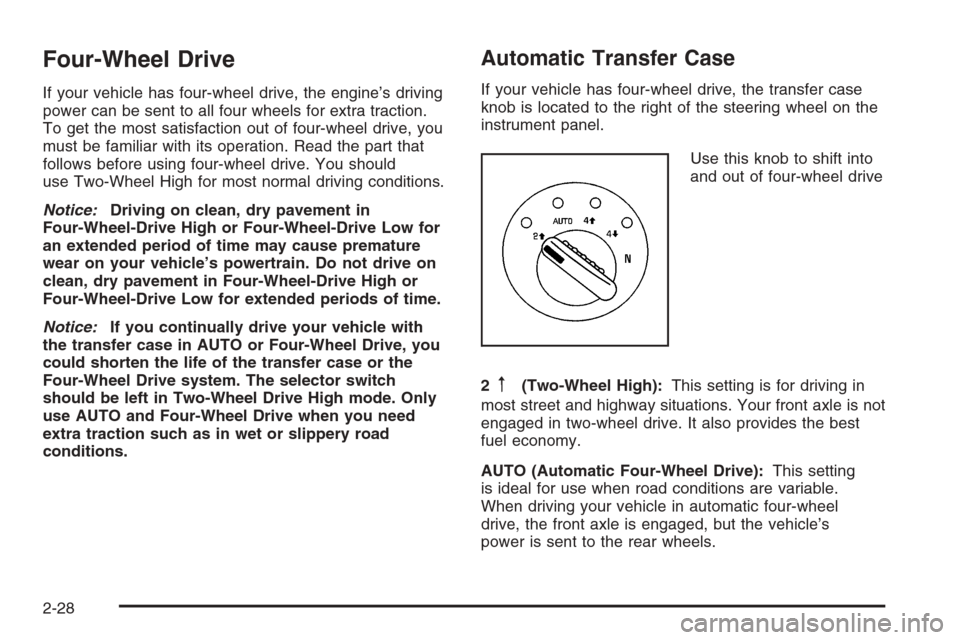
Four-Wheel Drive
If your vehicle has four-wheel drive, the engine’s driving
power can be sent to all four wheels for extra traction.
To get the most satisfaction out of four-wheel drive, you
must be familiar with its operation. Read the part that
follows before using four-wheel drive. You should
use Two-Wheel High for most normal driving conditions.
Notice:Driving on clean, dry pavement in
Four-Wheel-Drive High or Four-Wheel-Drive Low for
an extended period of time may cause premature
wear on your vehicle’s powertrain. Do not drive on
clean, dry pavement in Four-Wheel-Drive High or
Four-Wheel-Drive Low for extended periods of time.
Notice:If you continually drive your vehicle with
the transfer case in AUTO or Four-Wheel Drive, you
could shorten the life of the transfer case or the
Four-Wheel Drive system. The selector switch
should be left in Two-Wheel Drive High mode. Only
use AUTO and Four-Wheel Drive when you need
extra traction such as in wet or slippery road
conditions.
Automatic Transfer Case
If your vehicle has four-wheel drive, the transfer case
knob is located to the right of the steering wheel on the
instrument panel.
Use this knob to shift into
and out of four-wheel drive
2
m(Two-Wheel High):This setting is for driving in
most street and highway situations. Your front axle is not
engaged in two-wheel drive. It also provides the best
fuel economy.
AUTO (Automatic Four-Wheel Drive):This setting
is ideal for use when road conditions are variable.
When driving your vehicle in automatic four-wheel
drive, the front axle is engaged, but the vehicle’s
power is sent to the rear wheels.
2-28
Page 121 of 472

OnStar Virtual Advisor
OnStar Virtual Advisor is a feature of OnStar
Hands-Free Calling that uses your minutes to access
location-based weather, local traffic reports, and
stock quotes. By pressing the phone button and giving
a few simple voice commands, you can browse
through the various topics. See the OnStar Owner’s
Guide for more information (Only available in the
continental U.S.).
OnStar Steering Wheel Controls
Your vehicle may have a Talk/Mute button that can be
used to interact with OnStar Hands-Free Calling.
SeeAudio Steering Wheel Controls on page 3-105for
more information.
On some vehicles, you may have to hold the button for
a few seconds and give the command “ONSTAR” to
activate the OnStar Hands-Free Calling.
On some vehicles, the mute button can be used to dial
numbers into voicemail systems, or to dial phone
extensions. See the OnStar Owner’s Guide for more
information.
How OnStar Service Works
Your vehicle’s OnStar system has the capability of
recording and transmitting vehicle information. This
information is automatically sent to an OnStar Call
Center at the time of an OnStar button press,
Emergency button press or if your airbags or AACN
system deploys. The vehicle information usually includes
your GPS location and, in the event of a crash,
additional information regarding the accident that your
vehicle has been involved in (e.g. the direction from
which your vehicle was hit). When you use the Virtual
Advisor feature of OnStar Hands-Free Calling, your
vehicle also sends OnStar your GPS location so that we
can provide you with location-based services.
OnStar service cannot work unless your vehicle is in a
place where OnStar has an agreement with a wireless
service provider for service in that area. OnStar
service also cannot work unless you are in a place
where the wireless service provider OnStar has hired for
that area has coverage, network capacity and reception
when the service is needed, and technology that is
compatible with the OnStar service. Not all services are
available everywhere, particularly in remote or
enclosed areas, or at all times.
Location information about your vehicle is only available
if the GPS satellite signals are unobstructed and
available.
2-49
Page 132 of 472
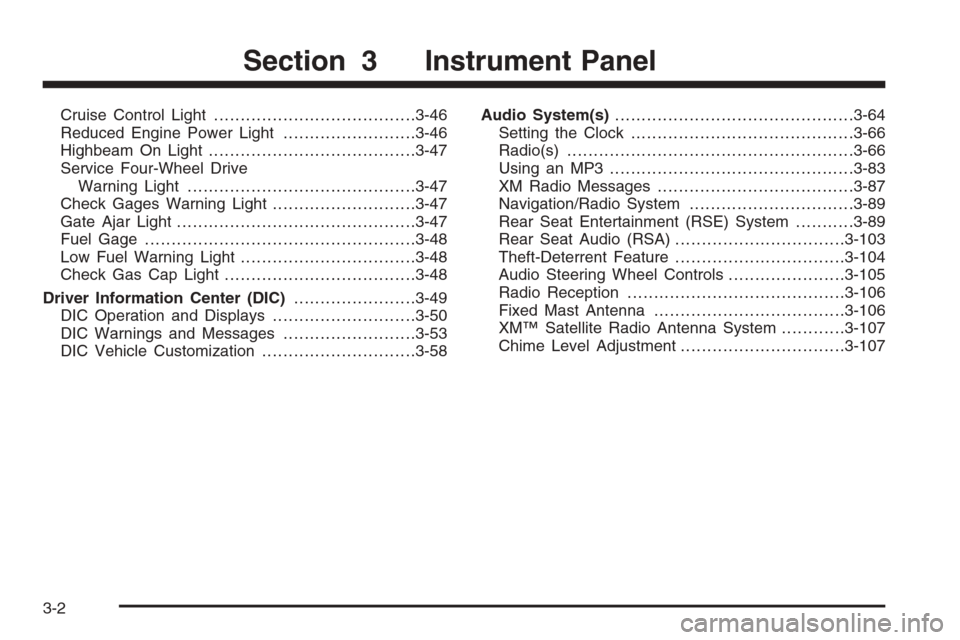
Cruise Control Light......................................3-46
Reduced Engine Power Light.........................3-46
Highbeam On Light.......................................3-47
Service Four-Wheel Drive
Warning Light...........................................3-47
Check Gages Warning Light...........................3-47
Gate Ajar Light.............................................3-47
Fuel Gage...................................................3-48
Low Fuel Warning Light.................................3-48
Check Gas Cap Light....................................3-48
Driver Information Center (DIC).......................3-49
DIC Operation and Displays...........................3-50
DIC Warnings and Messages.........................3-53
DIC Vehicle Customization.............................3-58Audio System(s).............................................3-64
Setting the Clock..........................................3-66
Radio(s)......................................................3-66
Using an MP3..............................................3-83
XM Radio Messages.....................................3-87
Navigation/Radio System...............................3-89
Rear Seat Entertainment (RSE) System...........3-89
Rear Seat Audio (RSA)................................3-103
Theft-Deterrent Feature................................3-104
Audio Steering Wheel Controls......................3-105
Radio Reception.........................................3-106
Fixed Mast Antenna....................................3-106
XM™ Satellite Radio Antenna System............3-107
Chime Level Adjustment...............................3-107
Section 3 Instrument Panel
3-2
Page 135 of 472
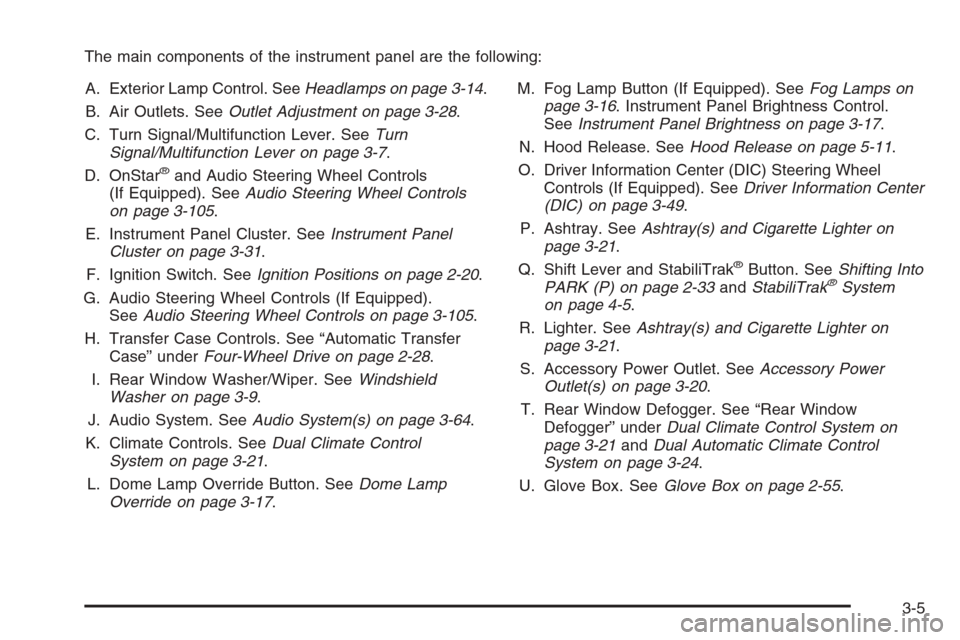
The main components of the instrument panel are the following:
A. Exterior Lamp Control. SeeHeadlamps on page 3-14.
B. Air Outlets. SeeOutlet Adjustment on page 3-28.
C. Turn Signal/Multifunction Lever. SeeTurn
Signal/Multifunction Lever on page 3-7.
D. OnStar
®and Audio Steering Wheel Controls
(If Equipped). SeeAudio Steering Wheel Controls
on page 3-105.
E. Instrument Panel Cluster. SeeInstrument Panel
Cluster on page 3-31.
F. Ignition Switch. SeeIgnition Positions on page 2-20.
G. Audio Steering Wheel Controls (If Equipped).
SeeAudio Steering Wheel Controls on page 3-105.
H. Transfer Case Controls. See “Automatic Transfer
Case” underFour-Wheel Drive on page 2-28.
I. Rear Window Washer/Wiper. SeeWindshield
Washer on page 3-9.
J. Audio System. SeeAudio System(s) on page 3-64.
K. Climate Controls. SeeDual Climate Control
System on page 3-21.
L. Dome Lamp Override Button. SeeDome Lamp
Override on page 3-17.M. Fog Lamp Button (If Equipped). SeeFog Lamps on
page 3-16. Instrument Panel Brightness Control.
SeeInstrument Panel Brightness on page 3-17.
N. Hood Release. SeeHood Release on page 5-11.
O. Driver Information Center (DIC) Steering Wheel
Controls (If Equipped). SeeDriver Information Center
(DIC) on page 3-49.
P. Ashtray. SeeAshtray(s) and Cigarette Lighter on
page 3-21.
Q. Shift Lever and StabiliTrak
®Button. SeeShifting Into
PARK (P) on page 2-33andStabiliTrak®System
on page 4-5.
R. Lighter. SeeAshtray(s) and Cigarette Lighter on
page 3-21.
S. Accessory Power Outlet. SeeAccessory Power
Outlet(s) on page 3-20.
T. Rear Window Defogger. See “Rear Window
Defogger” underDual Climate Control System on
page 3-21andDual Automatic Climate Control
System on page 3-24.
U. Glove Box. SeeGlove Box on page 2-55.
3-5
Page 136 of 472
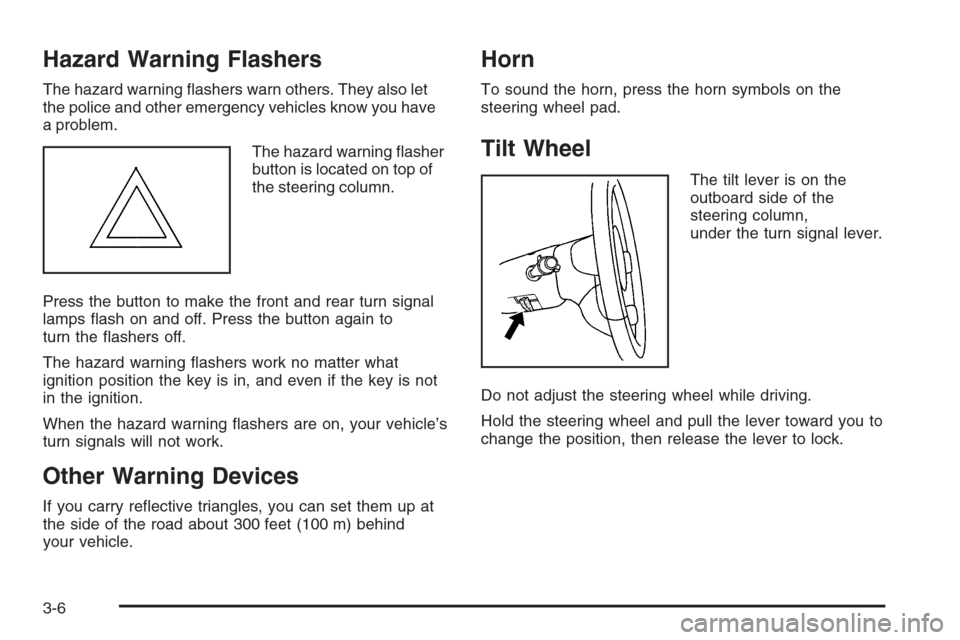
Hazard Warning Flashers
The hazard warning �ashers warn others. They also let
the police and other emergency vehicles know you have
a problem.
The hazard warning �asher
button is located on top of
the steering column.
Press the button to make the front and rear turn signal
lamps �ash on and off. Press the button again to
turn the �ashers off.
The hazard warning �ashers work no matter what
ignition position the key is in, and even if the key is not
in the ignition.
When the hazard warning �ashers are on, your vehicle’s
turn signals will not work.
Other Warning Devices
If you carry re�ective triangles, you can set them up at
the side of the road about 300 feet (100 m) behind
your vehicle.
Horn
To sound the horn, press the horn symbols on the
steering wheel pad.
Tilt Wheel
The tilt lever is on the
outboard side of the
steering column,
under the turn signal lever.
Do not adjust the steering wheel while driving.
Hold the steering wheel and pull the lever toward you to
change the position, then release the lever to lock.
3-6
Page 137 of 472
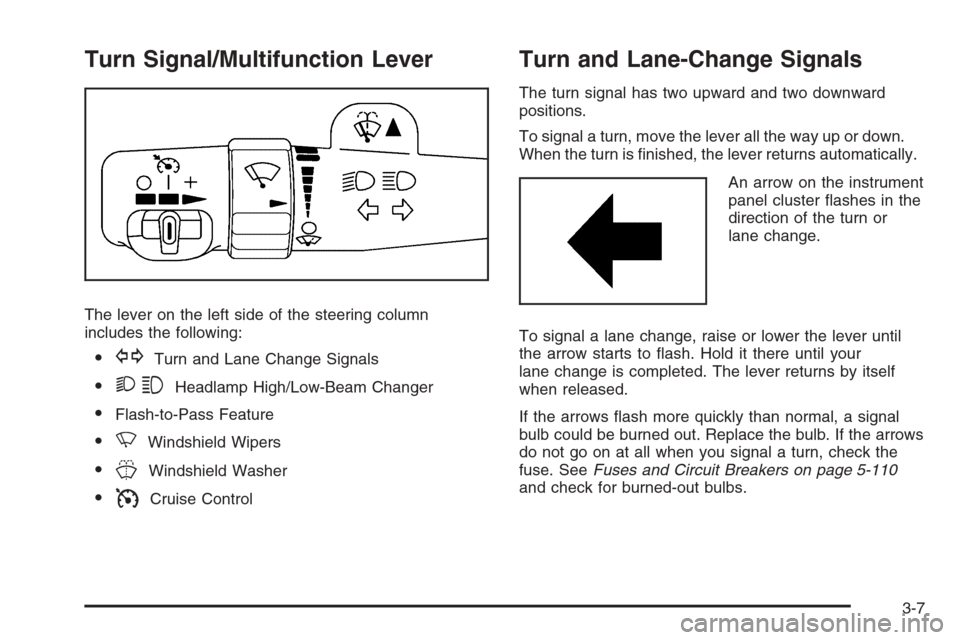
Turn Signal/Multifunction Lever
The lever on the left side of the steering column
includes the following:
GTurn and Lane Change Signals
23Headlamp High/Low-Beam Changer
Flash-to-Pass Feature
NWindshield Wipers
JWindshield Washer
ICruise Control
Turn and Lane-Change Signals
The turn signal has two upward and two downward
positions.
To signal a turn, move the lever all the way up or down.
When the turn is �nished, the lever returns automatically.
An arrow on the instrument
panel cluster �ashes in the
direction of the turn or
lane change.
To signal a lane change, raise or lower the lever until
the arrow starts to �ash. Hold it there until your
lane change is completed. The lever returns by itself
when released.
If the arrows �ash more quickly than normal, a signal
bulb could be burned out. Replace the bulb. If the arrows
do not go on at all when you signal a turn, check the
fuse. SeeFuses and Circuit Breakers on page 5-110
and check for burned-out bulbs.
3-7
Page 140 of 472
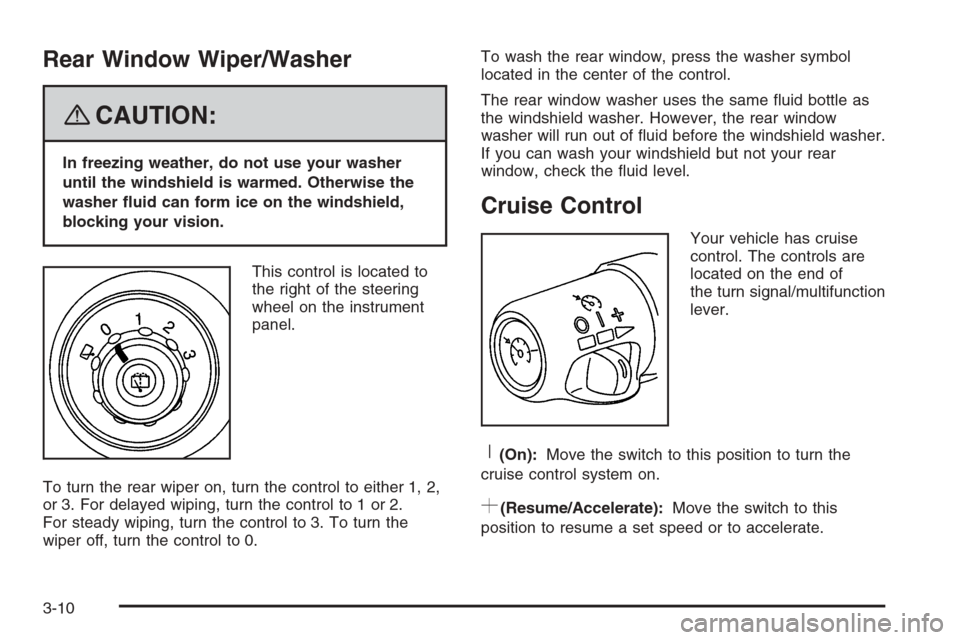
Rear Window Wiper/Washer
{CAUTION:
In freezing weather, do not use your washer
until the windshield is warmed. Otherwise the
washer �uid can form ice on the windshield,
blocking your vision.
This control is located to
the right of the steering
wheel on the instrument
panel.
To turn the rear wiper on, turn the control to either 1, 2,
or 3. For delayed wiping, turn the control to 1 or 2.
For steady wiping, turn the control to 3. To turn the
wiper off, turn the control to 0.To wash the rear window, press the washer symbol
located in the center of the control.
The rear window washer uses the same �uid bottle as
the windshield washer. However, the rear window
washer will run out of �uid before the windshield washer.
If you can wash your windshield but not your rear
window, check the �uid level.
Cruise Control
Your vehicle has cruise
control. The controls are
located on the end of
the turn signal/multifunction
lever.
R(On):Move the switch to this position to turn the
cruise control system on.
S(Resume/Accelerate):Move the switch to this
position to resume a set speed or to accelerate.
3-10
Page 144 of 472
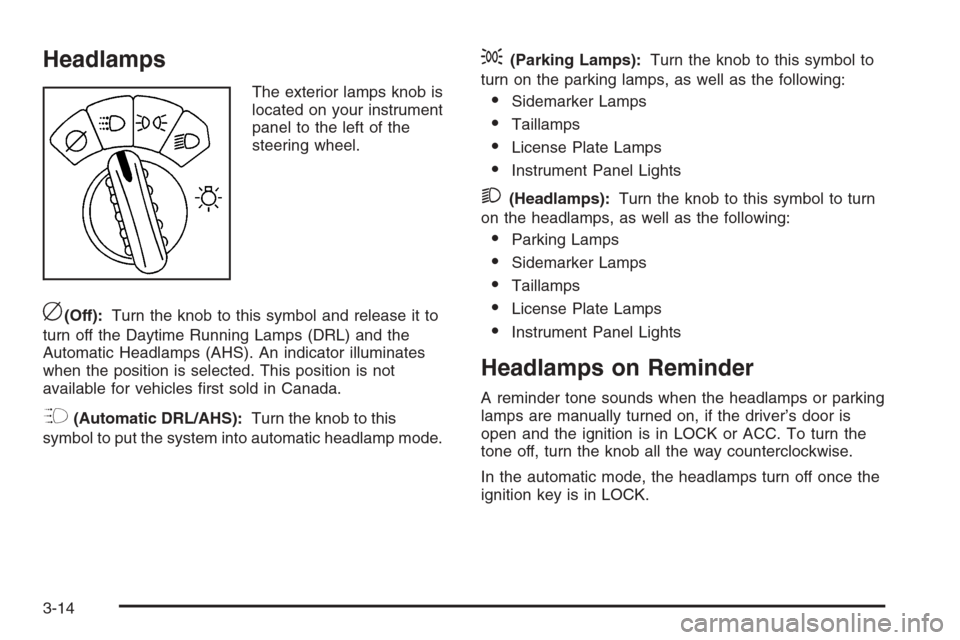
Headlamps
The exterior lamps knob is
located on your instrument
panel to the left of the
steering wheel.
c(Off):Turn the knob to this symbol and release it to
turn off the Daytime Running Lamps (DRL) and the
Automatic Headlamps (AHS). An indicator illuminates
when the position is selected. This position is not
available for vehicles �rst sold in Canada.
?(Automatic DRL/AHS):Turn the knob to this
symbol to put the system into automatic headlamp mode.
;(Parking Lamps):Turn the knob to this symbol to
turn on the parking lamps, as well as the following:
Sidemarker Lamps
Taillamps
License Plate Lamps
Instrument Panel Lights
2(Headlamps):Turn the knob to this symbol to turn
on the headlamps, as well as the following:
Parking Lamps
Sidemarker Lamps
Taillamps
License Plate Lamps
Instrument Panel Lights
Headlamps on Reminder
A reminder tone sounds when the headlamps or parking
lamps are manually turned on, if the driver’s door is
open and the ignition is in LOCK or ACC. To turn the
tone off, turn the knob all the way counterclockwise.
In the automatic mode, the headlamps turn off once the
ignition key is in LOCK.
3-14